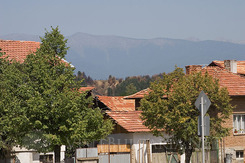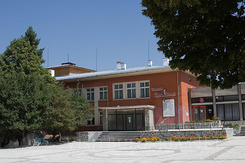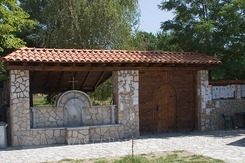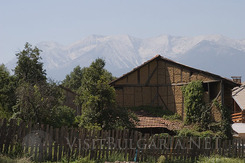Over one billion euro has been invested in the wellness and spa industry in Bulgaria over the past more...
| Search | Hotels / Accommodation | Vacations | Tours & Trips | Rent A Car | Transport | Flights | Conferences | Press Centre | Yachting |
- Hotels & Accommodation in Banya (Razlog)



- Aspa Vila Hotel
- Rimska Banya Hotel
- Sveti Georgi Hotel


- Aquilon Spa & Residence


- Spa Hotel Vita Springs
- Banya (Razlog) Guide
- Early booking in Banya (Razlog)
- All inclusive in Banya (Razlog)
- Last minute in Banya (Razlog)
- Hotels in Banya (Razlog)
- Apartments in Banya (Razlog)
- Villas in Banya (Razlog)
- Rural houses in Banya (Razlog)
- Vacations in Banya (Razlog)
- Transport To Banya (Razlog)
- Tours in Banya (Razlog)
- Conferences in Banya (Razlog)
- Articles on Banya (Razlog)
- News From Banya (Razlog)
- Holidays in Bulgaria
- All inclusive
- Beach
- Birdwatching
- Golf
- Health
- History
- Hunting
- Monasteries/ Religious
- Mountain biking
- Prom
- Rural
- Ski
- Spa & Wellness
- Trekking
- Water sports
- Weekend breaks
- Wine
- Conference
- Children Holidays
- Yachting
- Events
- Type of accommodation
- Hotels
- Apartments
- Villas
- Rural houses
- Destinations
- Aheloy
- Ahtopol
- Albena
- Apriltsi
- Arbanassi
- Asparuhovo
- Assenovgrad
- Bachkovo Monastery
- Balchik
- Bankya
- Bansko
- Banya (Karlovo)
- Banya (Razlog)
- Batak
- Beklemeto
- Belchin Bani
- Beli Iskar
- Belogradchik
- Berkovitsa
- Blagoevgrad
- Bodrost
- Bojichen
- Borovets
- Botevgrad
- Bourgas
- Bozhentsi
- Bratsigovo
- Brestovitsa
- Buzludja
- Byala
- Chepelare
- Cherepish Monastery
- Chernomorets
- Chiflik
- Devin
- Dimitrovgrad
- Dobarsko
- Dobrich
- Dobrinishte
- Dolna Banya
- Dospat
- Dryanovo
- Dupnitsa
- Dyuni
- Elena
- Elenite
- Elhovo
- Gabrovo
- Gela
- Golden Sands
- Gorna Oryahovitsa
- Gotse Delchev
- Govedartsi
- Grand Hotel Varna
- Harmanli
- Haskovo
- Haskovo Mineral Baths
- Hissarya
- Ivaylovgrad
- Kalofer
- Kamchia
- Kamen Bryag
- Kardjali
- Karlovo
- Kavarna
- Kazanlak
- Kiten
- Kom
- Koprivshtitsa
- Kosharitsa
- Kostenets
- Kostenkovtsi
- Kotel
- Kovatchevitsa
- Kranevo
- Kresna
- Kulinoto
- Kyustendil
- Lom
- Lovech
- Lozenets
- Lukovit
- Lyaskovets
- Madara
- Malko Tarnovo
- Malyovitsa
- Melnik
- Mezdra
- Momchilovtsi
- Montana
- Narechen Baths
- Near Golden Sands
- Nessebar
- Obzor
- Ognyanovo
- Osogovo
- Pamporovo
- Panagyurishte
- Panichishte
- Parshevitsa
- Pavel Banya
- Pavlikeni
- Pazardjik
- Pernik
- Petrich
- Pirdop
- Pleven
- Pliska
- Plovdiv
- Pomorie
- Pravets
- Preslav
- Primorsko
- Ravda
- Razgrad
- Razlog
- Ribaritsa
- Rila Monastery
- Riviera
- Rousse
- Rusalka
- Samokov
- Sandanski
- Sapareva Banya
- Semkovo
- Sevlievo
- Shabla
- Shipka
- Shipkovo
- Shiroka Laka
- Shkorpilovtsi
- Shoumen
- Silistra
- Sinemorets
- Sliven
- Smolyan
- Sofia
- Sopot
- Sozopol
- Srebarna
- St. Constantine & Elena
- Stara Zagora
- Starozagorski Baths
- Sunny Beach
- Sunny Day
- Sveti Vlas
- Svilengrad
- Svishtov
- Targovishte
- Teteven
- Tran
- Trigrad
- Troyan
- Tryavna
- Tsarevo
- Tsigov Chark
- Uzana
- Varna
- Varshets
- Veliko Tarnovo
- Velingrad
- Vidin
- Vitosha
- Voneshta Voda
- Vratsa
- Vratsata Gorge
- Yagoda
- Yakoruda
- Yambol
- Zlatitsa
- Zlatograd
- Bulgaria Guide
- General information
- Bulgarian Monasteries
- SPA Bulgaria
- The Black sea
- History
- Geography
- Maps
- Weather
- Airports in Bulgaria
- Webcams
- Forums
- Mountains in Bulgaria
- The Balkan Mountain Range
- Rila Mountain
- Pirin Mountain
- The Rodope Mountain
- Vitosha Mountain
- Travel Arrangements
- Visit Bulgaria
- Visa Requierments
- Choose Destination
- Flights to Bulgaria
- Transport in Bulgaria
- Advice
- Currency
- Official Holidays
Subscribe to newsletters to receive our hottest offers:
| Home > Blagoevgrad > Banya (Razlog) |
Banya (near Razlog)

Location: The village of Banya is situated in the south-west of Bulgaria, in a valley between the three big mountains Rila, Pirin and the Rhodopes. It is 156 km away from the capital Sofia and only 4 km to the east of the town of Razlog , and at about the same distance to the north of the ski centre and mountain resort of Bansko. The population of the resort is 3,000.
History: The mineral springs in the site are the reason this region to be settled very early. The first inhabitants are the Thracians, which is proved by the remains of their culture around the old bath and outside the village dated back about IV century BC. In II century BC the region was conquered by Philip II, the king of the Macedonian tribes. A temple of Apollo (as a god of health) was built then in the village. During the III century BC in the  region came Celts, and remained to live together with the Thracians. With the expansion of the Roman Empire during the I century BC the valley of Rila, Pirin and Rhodopes was joined to it. Traditional Rome thermals that can be seen even today, were built in the village. As the Empire was Christian already, the old temple of Apollo was destroyed and replaced by the “Holy Virgin” church (II century). After the breaking up of the Roman Empire (IV century), the village became a part of the Byzantium Empire. Very soon the Slavs came, but all tribes continued to live separately in peace. In IX century the region became a part of the Bulgarian state.
region came Celts, and remained to live together with the Thracians. With the expansion of the Roman Empire during the I century BC the valley of Rila, Pirin and Rhodopes was joined to it. Traditional Rome thermals that can be seen even today, were built in the village. As the Empire was Christian already, the old temple of Apollo was destroyed and replaced by the “Holy Virgin” church (II century). After the breaking up of the Roman Empire (IV century), the village became a part of the Byzantium Empire. Very soon the Slavs came, but all tribes continued to live separately in peace. In IX century the region became a part of the Bulgarian state.
 Bulgaria was conquered by the Ottoman Empire in the XIV century. The Christian church and churchyard were destroyed during the XVI-XVII century and a mosque was built. In 1801 the village was totally burned down, but XIX century was time of cultural and economic revival for the village. It was emancipated from the Ottoman Empire at the beginning of XX century (1912).
Bulgaria was conquered by the Ottoman Empire in the XIV century. The Christian church and churchyard were destroyed during the XVI-XVII century and a mosque was built. In 1801 the village was totally burned down, but XIX century was time of cultural and economic revival for the village. It was emancipated from the Ottoman Empire at the beginning of XX century (1912).
Sightseeing: There are several archeological sites in the village and its surroundings because of Banya’s long history. The old Roman thermals, which are about to be renovated, and “St. George” church are announced monuments of culture. The tradition of local crafts as iconography, wood-carving, loom and embroidery is still alive. In the village there are two warm mineral pools – one Olympic-size swimming pool and one for children.

Mineral water: The mineral springs of Banya are 72, situated in the village and at the foot of the height Zhensko bardo. The total capacity of the springs is about 76 l/s. Water temperature is between 37-57oC. The water is clean, scentless and without a precipitate, good for drinking. It contains of hydro-carbonate, sulephate, sodium, fluorine and silicon and is weakly mineralized. It is used for medical treatment of chronic inflammatory diseases of the locomotory system, chronic gynecological diseases and inflammatory diseases of the nervous system. There are also mud-curing deposits.
Tourism: Banya is currently undergoing massive development into a spa and wellness resort with plenty of new hotels, restaurants and other tourist facilities emerging each season. Its closeness of Bansko is the reason Banya to be preferred by the ski lovers. At the same time it preserves its traditional village style and is perfect not only for winter but for summer tourism, too.
More resorts and destinations in Blagoevgrad region
-
 Bansko
General Info: Bansko is one of the …
Bansko
General Info: Bansko is one of the …
-
 Blagoevgrad
Blagoevgrad is situated at the …
Blagoevgrad
Blagoevgrad is situated at the …
-
 Bodrost
Bodrost ski centre is situated in …
Bodrost
Bodrost ski centre is situated in …
-
 Dobarsko
Location: Nearby Razlog is located …
Dobarsko
Location: Nearby Razlog is located …
-
 Dobrinishte
Dobrinishte is a synonym of alpine …
Dobrinishte
Dobrinishte is a synonym of alpine …
-
 Gotse Delchev
Location: Gotse Delchev is situated …
Gotse Delchev
Location: Gotse Delchev is situated …
-
 Kovatchevitsa
Location: Kovachevitsa village is …
Kovatchevitsa
Location: Kovachevitsa village is …
-
 Kresna
Location: Kresna is located in …
Kresna
Location: Kresna is located in …
-
 Kulinoto
Kulinoto is a site in the northern …
Kulinoto
Kulinoto is a site in the northern …
-
 Melnik
Melnik is situated in the …
Melnik
Melnik is situated in the …
-
 Ognyanovo
Location: Ognyanovo village is …
Ognyanovo
Location: Ognyanovo village is …
-
 Petrich
Location: Petrich is situated in …
Petrich
Location: Petrich is situated in …
-
 Razlog
The town of Razlog is situated in …
Razlog
The town of Razlog is situated in …
-
 Sandanski
Location: Sandanski is situated 190 …
Sandanski
Location: Sandanski is situated 190 …
-
 Semkovo
The resort site of Semkovo is 17 …
Semkovo
The resort site of Semkovo is 17 …
-
 Yakoruda
Location: Yakoruda is a small …
Yakoruda
Location: Yakoruda is a small …






















